Combined Searches of Chinese Language and English Language Databases Provide More Comprehensive Data on the Distribution of Five Pest Thrips Species in China for Use in Pest Risk Assessment
Abstract
1. Introduction
2. Methods
2.1. Databases
2.2. Thrips Species
2.3. Database Searches
2.4. Publication Screening
2.5. Number of Publications Comparison (Quantitative)
3. Results
3.1. Frankliniella Schultzei
3.2. Selenothrips rubrocinctus
3.3. Scirtothrips dorsalis
3.4. Thrips palmi
3.5. Thrips hawaiiensis
3.6. Publication Patterns over Time
4. Discussion
4.1. Thrips Distribution in China
4.2. Number of Publications
4.3. Use of Chinese Script Made Up of Chinese Characters
4.4. Extent of Distribution
4.5. Chinese Databases
5. Conclusions
Supplementary Materials
Author Contributions
Funding
Institutional Review Board Statement
Informed Consent Statement
Data Availability Statement
Acknowledgments
Conflicts of Interest
References
- Bright, C. Invasive species: Pathogens of globalization. Foreign Policy 1999, 116, 50–64. [Google Scholar] [CrossRef]
- Lockwood, J.L.; Cassey, P.; Blackburn, T. The role of propagule pressure in explaining species invasions. Trends Ecol. Evol. 2005, 20, 223–228. [Google Scholar] [CrossRef] [PubMed]
- Meyerson, L.A.; Mooney, H.A. Invasive alien species in an era of globalization. Front. Ecol. Environ. 2007, 5, 199–208. [Google Scholar] [CrossRef]
- Hulme, P.E. Trade, transport and trouble: Managing invasive species pathways in an era of globalization. J. Appl. Ecol. 2009, 46, 10–18. [Google Scholar] [CrossRef]
- Seebens, H.; Blackburn, T.M.; Dyer, E.E.; Genovesi, P.; Hulme, P.E.; Jeschke, J.M.; Pagad, S.; Pyšek, P.; Winter, M.; Arianoutsou, M. No saturation in the accumulation of alien species worldwide. Nat. Commun. 2017, 8, 14435. [Google Scholar] [CrossRef]
- Holmes, T.P.; Aukema, J.E.; Von Holle, B.; Liebhold, A.; Sills, E. Economic impacts of invasive species in forest past, present, and future. In The Year In Ecology and Conservation Biology. Ann. N. Y. Acad. Sci. 2009, 1162, 18–38. [Google Scholar] [CrossRef]
- Hoffmann, B.D.; Broadhurst, L.M. The economic cost of managing invasive species in Australia. NeoBiota 2016, 31, 1. [Google Scholar] [CrossRef]
- Mollot, G.; Pantel, J.; Romanuk, T. The effects of invasive species on the decline in species richness: A global meta-analysis. Adv. Ecol. Res. 2017, 56, 61–83. [Google Scholar]
- Linders, T.; Bekele, K.; Schaffner, U.; Allan, E.; Alamirew, T.; Choge, S.K.; Eckert, S.; Haji, J.; Muturi, G.; Mbaabu, P.R.; et al. The impact of invasive species on social-ecological systems: Relating supply and use of selected provisioning ecosystem services. Ecosyst. Serv. 2020, 41, 101055. [Google Scholar] [CrossRef]
- Radcliffe, E.B.; Hutchison, W.D.; Cancelado, R.E. Integrated Pest Management: Concepts, Tactics, Strategies and Case Studies; Cambridge University Press: Cambridge, UK, 2009. [Google Scholar]
- Altieri, M.; Nicholls, C. Biodiversity and Pest Management in Agroecosystems; CRC Press: Boca Raton, FL, USA, 2018. [Google Scholar]
- Jenkins, P.T.; Mooney, H.A. The United States, China, and invasive species: Present status and future prospects. Biol. Invasions 2006, 8, 1589–1593. [Google Scholar] [CrossRef]
- Paini, D.R.; Sheppard, A.W.; Cook, D.C.; De Barro, P.J.; Worner, S.P.; Thomas, M.B. Global threat to agriculture from invasive species. Proc. Natl. Acad. Sci. USA 2016, 113, 7575–7579. [Google Scholar] [CrossRef] [PubMed]
- Liu, W. Scientific understanding of the Belt and Road Initiative of China and related research themes. Prog. Geogr. 2015, 34, 538–544. [Google Scholar]
- Huang, Y. Understanding China’s Belt & Road initiative: Motivation, framework and assessment. China Econ. Rev. 2016, 40, 314–321. [Google Scholar]
- Woetzel, J.; Seong, J.; Leung, N.; Ngai, J.; Manyika, J.; Madgavkar, A.; Lund, S.; Mironenko, A. China and the World: Inside the Dynamics of a Changing Relationship; McKinsey Global Institute: San Francisco, CA, USA, 2019. [Google Scholar]
- Xu, B.; Shaw, N.; Gee, M.; Teulon, D. A quantitative comparison of articles on two pests and two pathogens of biosecurity risk to New Zealand extracted from International and Chinese databases. N. Z. Plant Prot. 2016, 69, 176–185. [Google Scholar] [CrossRef]
- Teulon, D.A.; Xu, B. Biosecurity risks from stink bugs to New Zealand kiwifruit identified in Chinese language literature. N. Z. Plant Prot. 2018, 71, 140–150. [Google Scholar] [CrossRef][Green Version]
- Zhou, P.; Leydesdorff, L. A comparison between the China Scientific and Technical Papers and Citations Database and the Science Citation Index in terms of journal hierarchies and interjournal citation relations. J. Am. Soc. Inf. Sci. Technol. 2007, 58, 223–236. [Google Scholar] [CrossRef]
- Yu, F.; Akin-Fajiye, M.; Thapa Magar, K.; Ren, J.; Gurevitch, J. A global systematic review of ecological field studies on two major invasive plant species, Ageratina adenophora and Chromolaena odorata. Divers. Distrib. 2016, 22, 1174–1185. [Google Scholar] [CrossRef]
- Shu, F.; Julien, C.-A.; Larivière, V. Does the web of science accurately represent chinese scientific performance? J. Assoc. Inf. Sci. Technol. 2019, 70, 1138–1152. [Google Scholar] [CrossRef]
- Zhang, D.; Xu, J.; Zhang, Y.; Wang, J.; He, S.; Zhou, X. Study on sustainable urbanization literature based on web of science, scopus, and China national knowledge infrastructure: A scientometric analysis in citespace. J. Clean. Prod. 2020, 264, 121537. [Google Scholar] [CrossRef]
- Worner, S.P.; Gevrey, M. Modelling global insect pest species assemblages to determine risk of invasion. J. Appl. Ecol. 2006, 43, 858–867. [Google Scholar] [CrossRef]
- Liang, L.; Clark, J.T.; Kong, N.; Rieske, L.K.; Fei, S. Spatial analysis facilitates invasive species risk assessment. For. Ecol. Manag. 2014, 315, 22–29. [Google Scholar] [CrossRef]
- He, P.; Lu, W.; Luo, Y. A bibliometric analysis on literatures of biological invasion. J. Beijing For. Univ. 2009, 31, 77–83. [Google Scholar]
- Wan, J.; Yang, Y.; Peng, L.; Wang, R. A bibliometric analysis of research on biological invasions of China and Australia. J. Eneviron. Entomol. 2017, 39, 472–479. [Google Scholar]
- Wu, H. A bibliometrical analysis of biological invasions under the global climate change. Guihaia 2017, 37, 934–946. [Google Scholar]
- Xu, J.; Yuan, X. Online scholarly publishing in China: Who? What? How? Learn. Publ. 2013, 26, 89–100. [Google Scholar] [CrossRef]
- CABI. Crop Protection Compendium; CAB International: Wallingford, UK, 2017. [Google Scholar]
- CABI. Crop Protection Compendium; CAB International: Wallingford, UK, 2021. [Google Scholar]
- Hoddle, M.S.; Mound, L.A.; Paris, D.L. Thrips of California. Available online: https://keys.lucidcentral.org/keys/v3/thrips_of_california/Thrips_of_California.html (accessed on 10 September 2021).
- Mound, L.; Nielsen, M.; Hastings, A. Thysanoptera Aotearoa—Thrips of New Zealand; Lucidcentral.org; Identic Pty Ltd.: Brisbane, Australia, 2017. [Google Scholar]
- MPI. Official New Zealand Pest Register. Available online: https://pierpestregister.mpi.govt.nz/PestsRegister/ImportCommodity/ (accessed on 10 September 2021).
- CNKI. The Taiwan Academic Literature Database in CNKI. Available online: https://scholar.cnki.net/news/taiwan/public.html#:~:text=%E5%8D%8E%E8%89%BA%E6%95%B0%E4%BD%8D%E8%82%A1%E4%BB%BD%E6%9C%89%E9%99%90,%E7%A7%8D%EF%BC%8C%E8%BF%87%E5%88%8A511%E7%A7%8D%E3%80%82 (accessed on 28 September 2021).
- The Central People’s Government of China. Administrative Divisions of the People’s Republic of China. Available online: http://www.gov.cn/test/2005-06/15/content_18253.htm (accessed on 10 June 2017).
- Hartzell, M. China’s Administrative Divisions … or, When Is a “City” Not a “City”? Available online: http://matthartzell.blogspot.com/ (accessed on 10 September 2017).
- Hijmans, R.; Guarino, L.; Mathur, P. Manual of DIVA-GIS, Version 7.5. Available online: http://www.diva-gis.org./ (accessed on 25 February 2021).
- Xie, Y.; Li, Z.; Zhang, H. Phytophagous thrips species in Guangxi Province and one newly recorded species of the genus Frankliniella from China. Chin. J. Appl. Entomol. 2011, 48, 757–763. (In Chinese) [Google Scholar]
- Webster, J.; Watson, R.T. Analyzing the past to prepare for the future: Writing a literature review. MIS Q. 2002, 26, 13–23. [Google Scholar]
- Boote, D.N.; Beile, P. Scholars before researchers: On the centrality of the dissertation literature review in research preparation. Educ. Res. 2005, 34, 3–15. [Google Scholar] [CrossRef]
- Maggio, L.A.; Sewell, J.L.; Artino, A.R., Jr. The literature review: A foundation for high-quality medical education research. J. Grad. Med. Educ. 2016, 8, 297–303. [Google Scholar] [CrossRef]
- Mirab-balou, M.; Tong, X.; Feng, J.; Chen, X. Thrips (Insecta: Thysanoptera) of China. Check List 2011, 7, 720–744. [Google Scholar] [CrossRef]
- Gao, Y.-F.; Gong, Y.-J.; Cao, L.-J.; Chen, J.-C.; Gao, Y.-L.; Mirab-balou, M.; Chen, M.; Hoffmann, A.A.; Wei, S.-J. Geographical and interspecific variation in susceptibility of three common thrips species to the insecticide, spinetoram. J. Pest Sci. 2021, 94, 93–99. [Google Scholar] [CrossRef]
- Henry, A. Five Best Language Translation Tools. Available online: https://www.lifehacker.com.au/2015/10/five-best-language-translation-tools/ (accessed on 20 June 2017).
- Groves, M.; Mundt, K. Friend or foe? Google Translate in language for academic purposes. Engl. Specif. Purp. 2015, 37, 112–121. [Google Scholar] [CrossRef]
- People’s Government of Yunnan Province. Overview of Yunnan. Available online: http://www.yn.gov.cn/yngk/ (accessed on 15 September 2021).
- Hu, H.; Singhasivanon, P.; Salazar, N.; Thimasarn, K.; Li, X.; Wu, Y.; Yang, H.; Zhu, D.; Supavej, S.; Looareesuwan, S. Factors influencing malaria endemicity in Yunnan Province, PR China. Southeast Asian J. Trop. Med. Public Health 1998, 29, 191–200. [Google Scholar] [PubMed]
- Ricciardi, A.; Steiner, W.W.M.; Mack, R.N.; Simberloff, D. Toward a global information system for invasive species. BioScience 2000, 50, 239–244. [Google Scholar] [CrossRef]
- Vilizzi, L.; Copp, G.H.; Hill, J.E.; Adamovich, B.; Aislabie, L.; Akin, D.; Al-Faisal, A.J.; Almeida, D.; Azmai, M.N.A.; Bakiu, R.; et al. A global-scale screening of non-native aquatic organisms to identify potentially invasive species under current and future climate conditions. Sci. Total Environ. 2021, 788, 147868. [Google Scholar] [CrossRef]
- Wu, Y.; Pan, Y.; Zhang, Y.; Ma, Z.; Pang, J.; Guo, H.; Xu, B.; Yang, Z. China Scientific and Technical Papers and Citations (CSTPC): History, impact and outlook. Scientometrics 2004, 60, 385–397. [Google Scholar] [CrossRef]
- ISTIC. Statistical Data of Chinese S&T Papers; ISTIC: Beijing, China, 2014. [Google Scholar]
- Cyranoski, D. China splashes millions on hundreds of home-grown journals. Nature 2019, 576, 346–348. [Google Scholar] [CrossRef]
- Sharma, Y. China Shifts from Reliance on International Publications. Available online: https://www.universityworldnews.com/post.php?story=20200225181649179#:~:text=The%20shift%20away%20from%20international,international%20publication%20citations%2C%20experts%20say (accessed on 15 January 2021).
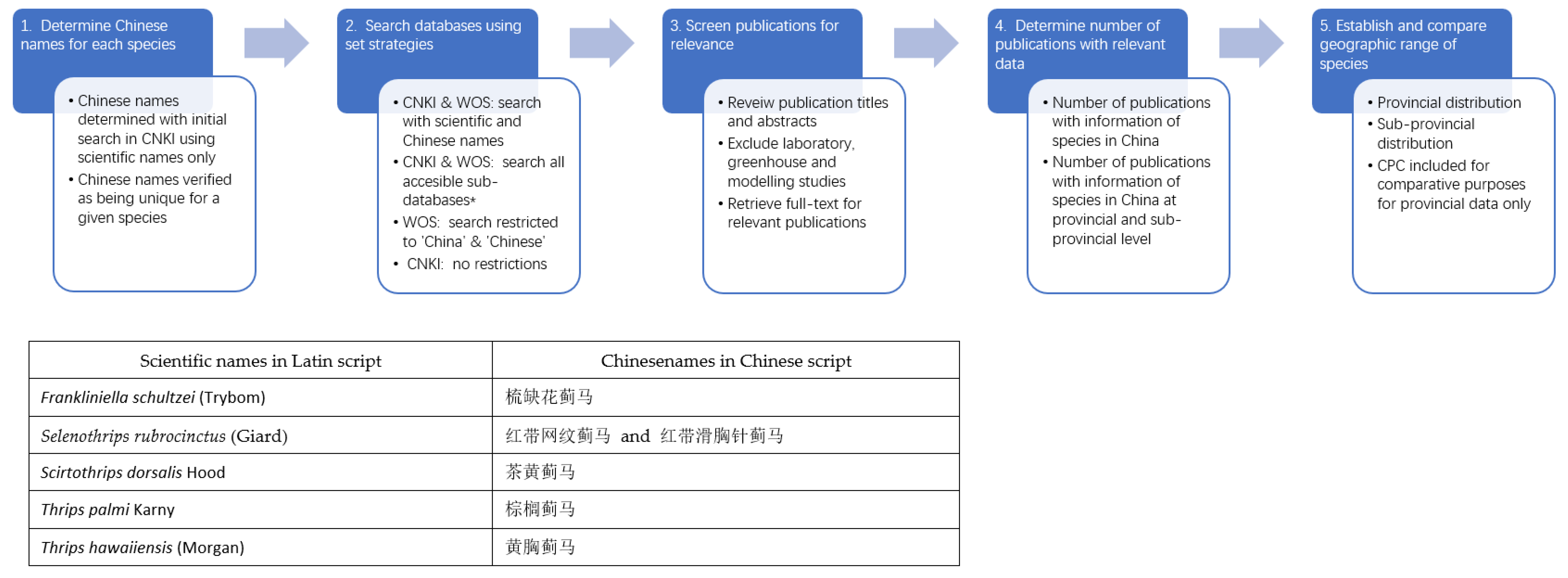
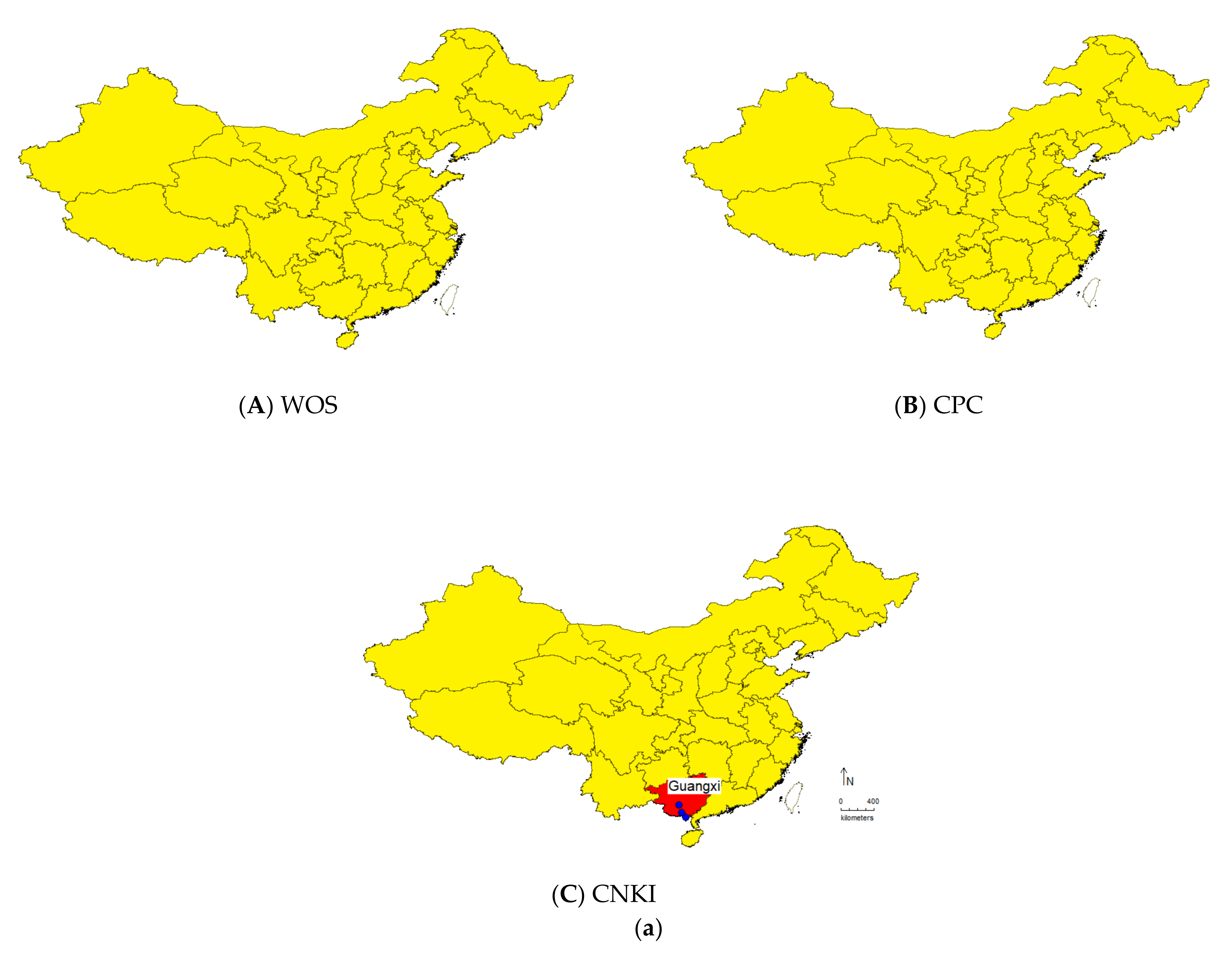
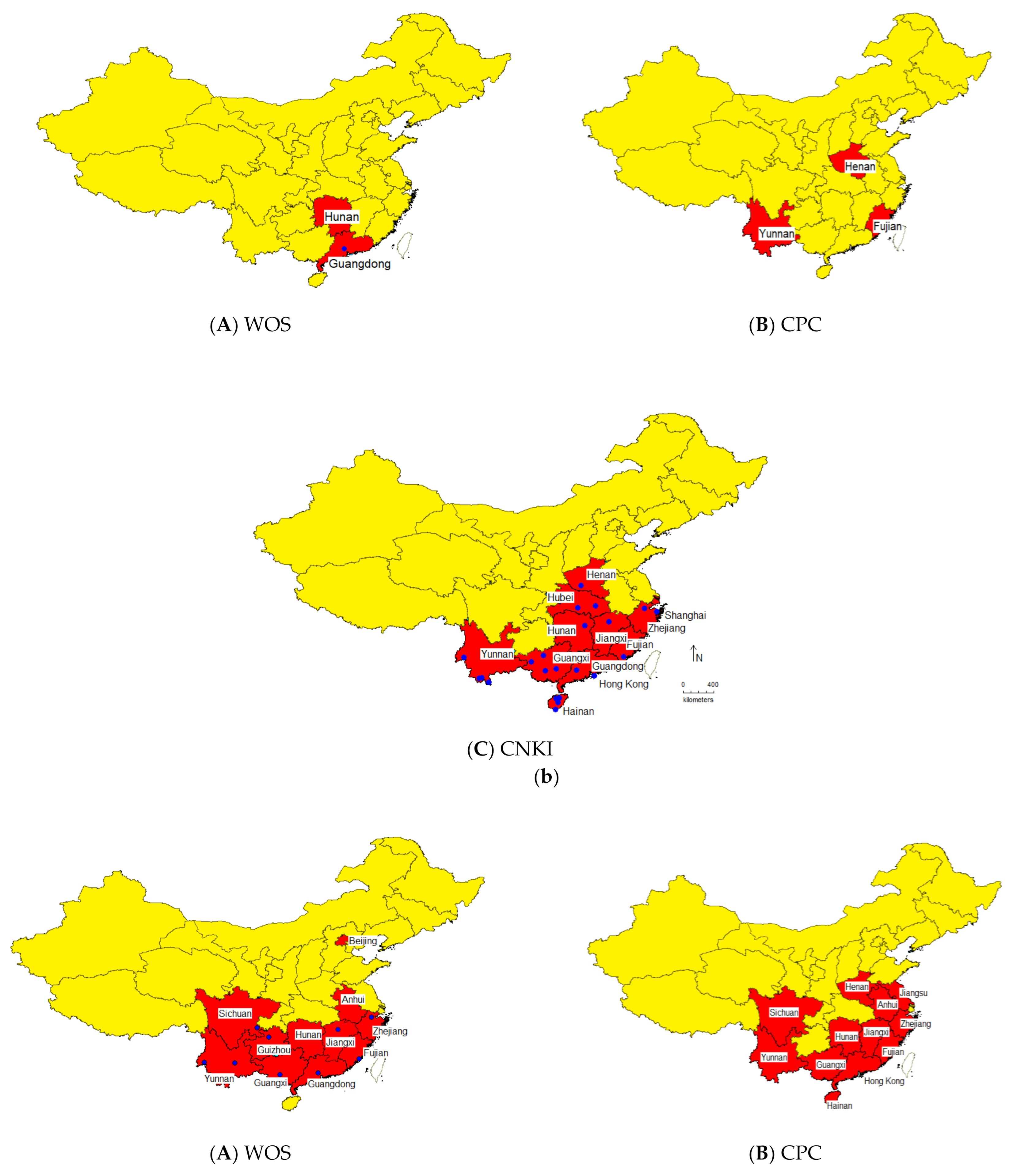
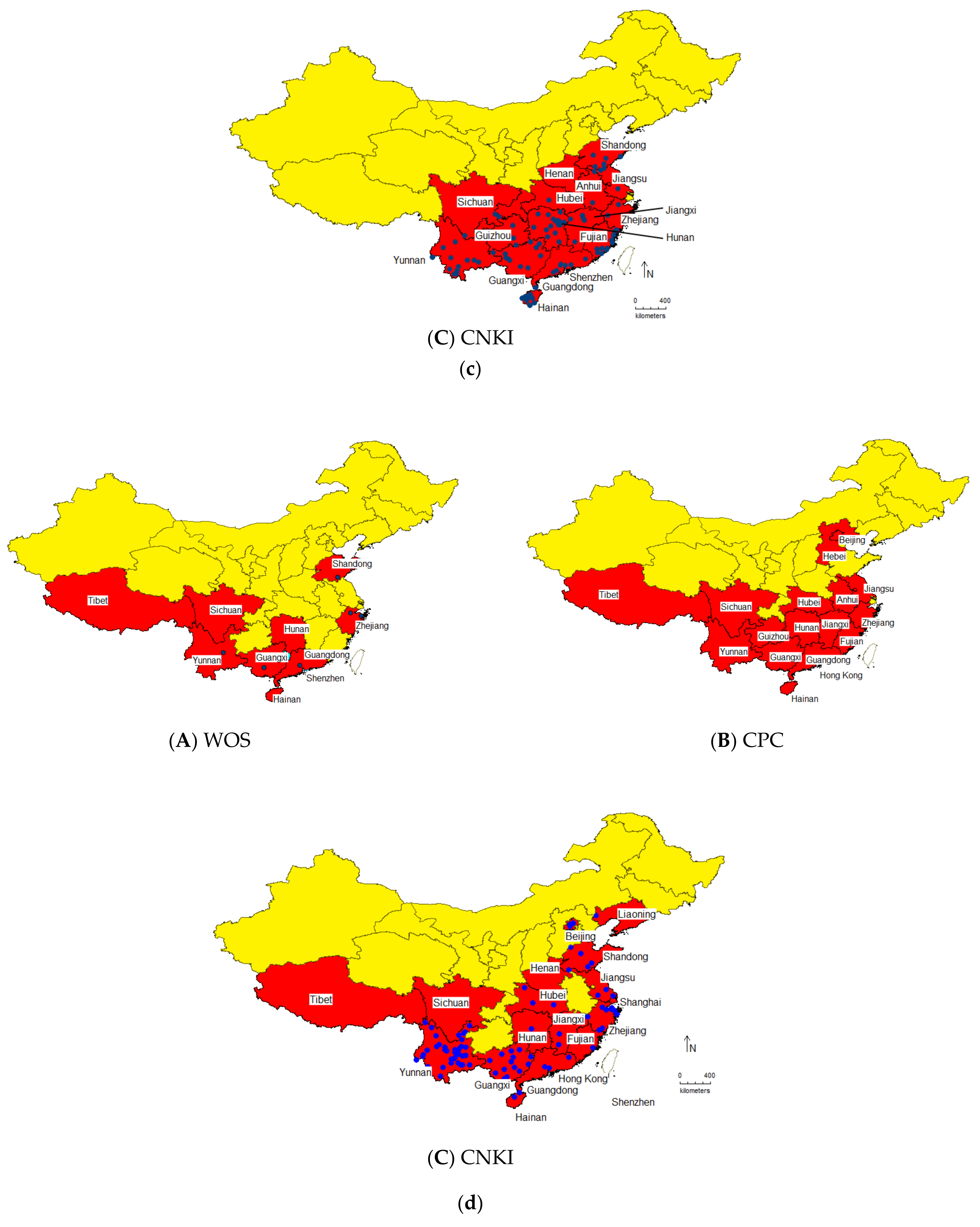
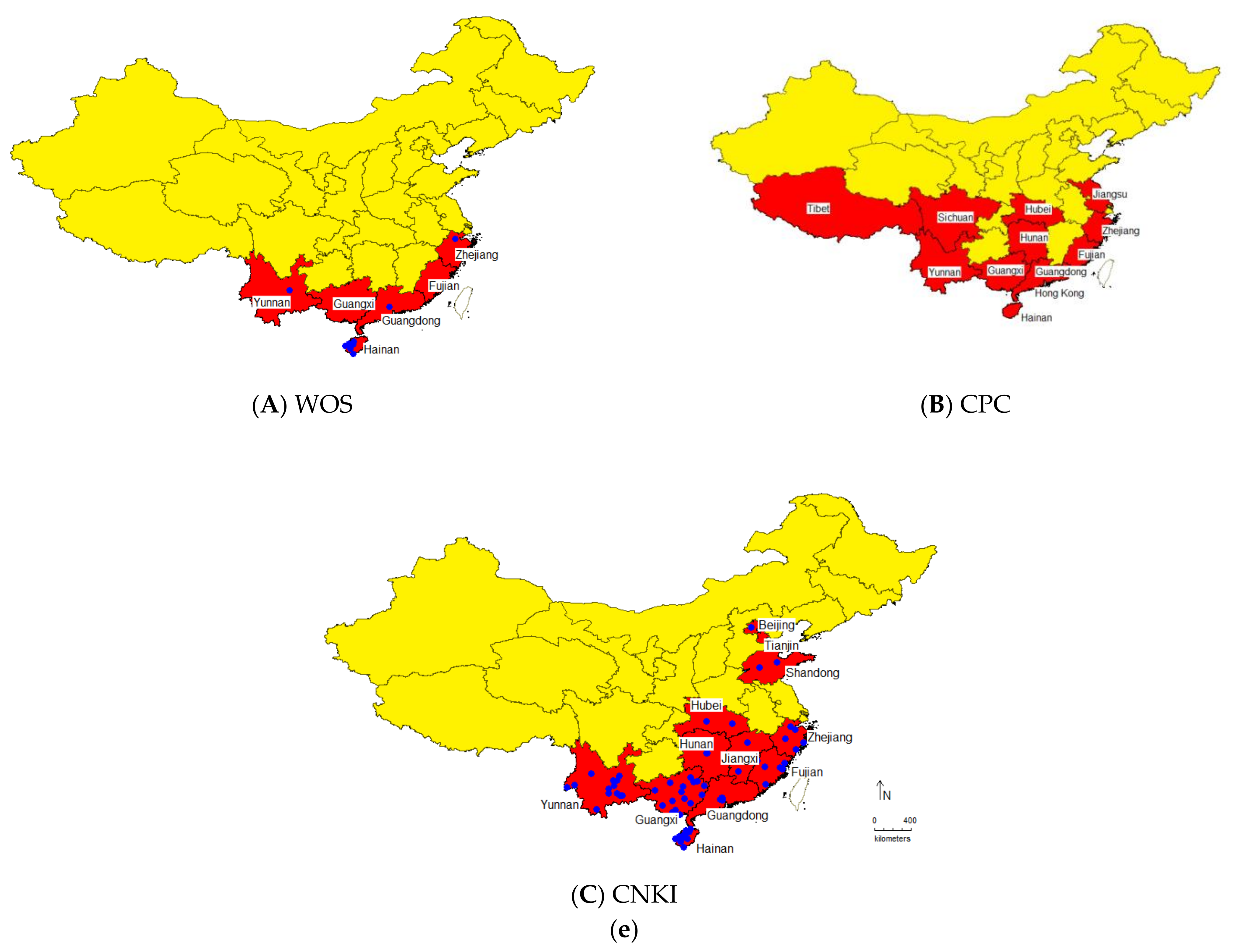
 , WOS
, WOS  and listed in CPC
and listed in CPC  .
.
 , WOS
, WOS  and listed in CPC
and listed in CPC  .
.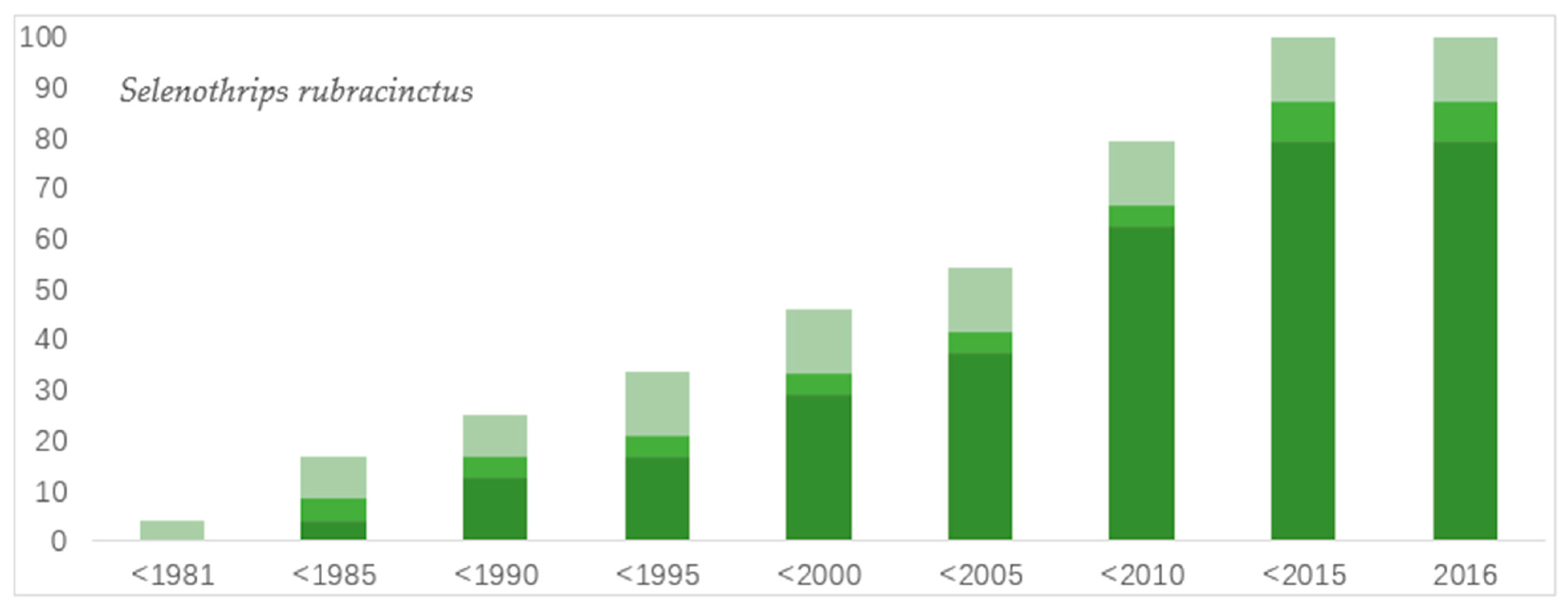
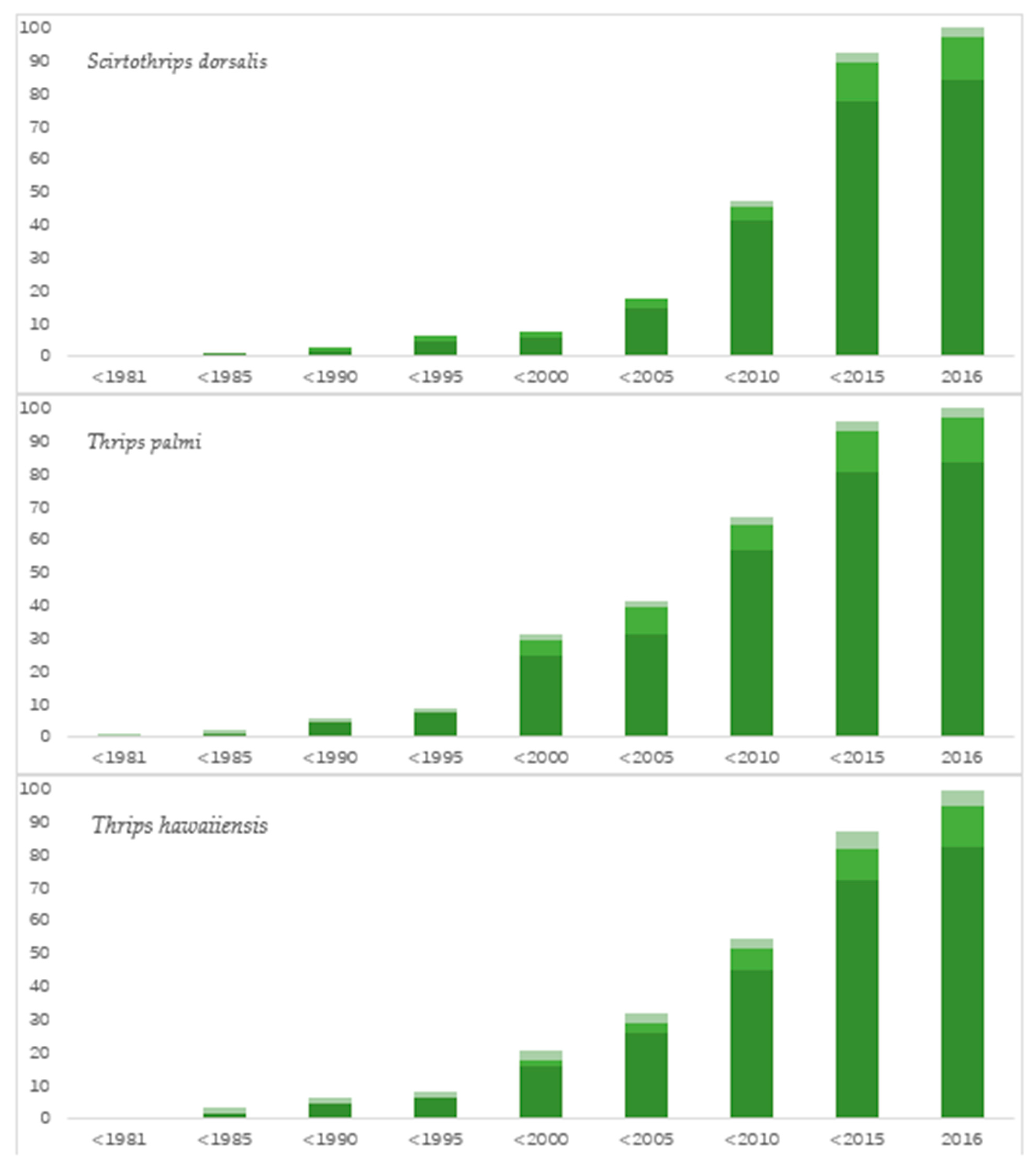
| WOS | CNKI | |||
|---|---|---|---|---|
| Latin Script | Chinese Script | Latin Script | Chinese Script | |
| Frankliniella schultzei | ||||
| Presence in China | 2 | 0 | 1 | 1 |
| Presence in a Chinese province or sub-provincial entity | 0 | 0 | 1 | 1 |
| Selenothrips rubrocinctus | ||||
| Presence in China | 3 | 0 | 8 | 18 |
| Presence in a Chinese province or sub-provincial entity | 2 | 0 | 7 | 16 |
| Scirtothrips dorsalis | ||||
| Presence in China | 17 | 4 | 43 | 175 |
| Presence in a Chinese province or sub-provincial entity | 14 | 4 | 34 | 93 |
| Thrips palmi | ||||
| Presence in China | 22 | 2 | 63 | 188 |
| Presence in a Chinese province or sub-provincial entity | 12 | 2 | 30 | 64 |
| Thrips hawaiiensis | ||||
| Presence in China | 11 | 4 | 28 | 55 |
| Presence in a Chinese province or sub-provincial entity | 7 | 4 | 27 | 46 |
| Level of Distribution Data | WOS | CNKI | CPC | |||||
|---|---|---|---|---|---|---|---|---|
| Latin Script Search | Chinese Script Search | Combined Search | Latin Script Search | Chinese Script Search | Combined Search | Listed | ||
| Frankliniella schultzei | Province | 0 | 0 | 0 | 1 | 1 | 1 | 0 |
| Sub-province | 0 | 0 | 0 | 3 | 3 | 3 | - | |
| Selenothrips rubrocinctus | Province | 2 | 0 | 2 | 3 | 11 + HK * | 11 + HK | 3 |
| Sub-province | 1 | 0 | 1 | 18 | 16 | 26 | - | |
| Scirtothrips dorsalis | Province | 11 | 4 | 11 | 13 | 16 | 17 | 12 + HK |
| Sub-province | 10 | 2 | 10 | 56 | 70 | 92 | - | |
| Thrips palmi | Province | 10 | 1 | 10 | 16 | 18 | 18 + HK | 16 + HK |
| Sub-province | 6 | 1 | 6 | 28 | 89 | 91 | - | |
| Thrips hawaiiensis | Province | 6 | 6 | 6 | 8 | 12 | 12 | 11 + HK |
| Sub-province | 10 | 8 | 10 | 39 | 64 | 68 | - | |
Publisher’s Note: MDPI stays neutral with regard to jurisdictional claims in published maps and institutional affiliations. |
© 2022 by the authors. Licensee MDPI, Basel, Switzerland. This article is an open access article distributed under the terms and conditions of the Creative Commons Attribution (CC BY) license (https://creativecommons.org/licenses/by/4.0/).
Share and Cite
Xu, B.; Teulon, D.A.J. Combined Searches of Chinese Language and English Language Databases Provide More Comprehensive Data on the Distribution of Five Pest Thrips Species in China for Use in Pest Risk Assessment. Sustainability 2022, 14, 2920. https://doi.org/10.3390/su14052920
Xu B, Teulon DAJ. Combined Searches of Chinese Language and English Language Databases Provide More Comprehensive Data on the Distribution of Five Pest Thrips Species in China for Use in Pest Risk Assessment. Sustainability. 2022; 14(5):2920. https://doi.org/10.3390/su14052920
Chicago/Turabian StyleXu, Bingqin, and David A. J. Teulon. 2022. "Combined Searches of Chinese Language and English Language Databases Provide More Comprehensive Data on the Distribution of Five Pest Thrips Species in China for Use in Pest Risk Assessment" Sustainability 14, no. 5: 2920. https://doi.org/10.3390/su14052920
APA StyleXu, B., & Teulon, D. A. J. (2022). Combined Searches of Chinese Language and English Language Databases Provide More Comprehensive Data on the Distribution of Five Pest Thrips Species in China for Use in Pest Risk Assessment. Sustainability, 14(5), 2920. https://doi.org/10.3390/su14052920






